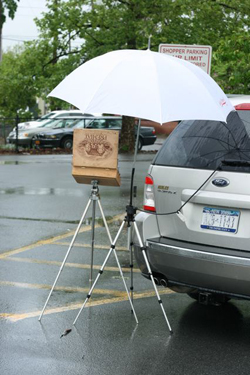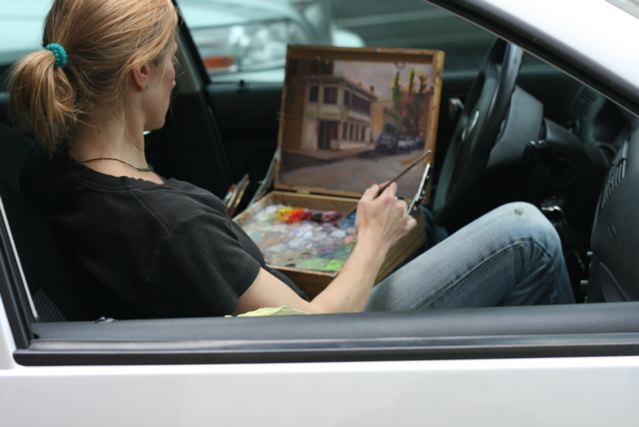Arts & Entertainment
Arts & Entertainment
Resurgence of Interest in Surrealism
- Details
- Published: 06 April 2012 06 April 2012
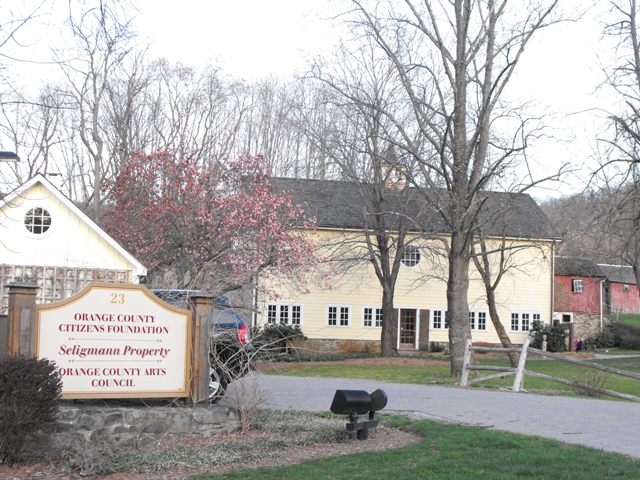 There’s been a resurgence of interest in surrealism in Orange County, NY, most notably and of late at The Seligmann Estate in Sugarloaf, NY. On March 30th an art exhibition, "A Homage to Kurt Seligmann," curated by Jonathan Talbot and Jessica Lawrence, was one in a series of events over the last year bringing to light some of this exciting activity. The show was packed with enthusiastic viewers and showcased local artists working in the medium of collage to pay homage to the life of Seligmann. Although Seligmann himself was not a collagist, surrealism has been important to the development of collage, as in the case of Max Ernst, one of the primary pioneers of the Dada movement and Surrealism.
There’s been a resurgence of interest in surrealism in Orange County, NY, most notably and of late at The Seligmann Estate in Sugarloaf, NY. On March 30th an art exhibition, "A Homage to Kurt Seligmann," curated by Jonathan Talbot and Jessica Lawrence, was one in a series of events over the last year bringing to light some of this exciting activity. The show was packed with enthusiastic viewers and showcased local artists working in the medium of collage to pay homage to the life of Seligmann. Although Seligmann himself was not a collagist, surrealism has been important to the development of collage, as in the case of Max Ernst, one of the primary pioneers of the Dada movement and Surrealism.
 Artist Daniel Mack, who has been a key coordinator in promoting Surrealism at the Seligmann and who has produced a blog on the subject, displayed a piece of his own called “Accidents,” which explores the irony between Seligmann’s death as accidental (as was pronounced by the media) against Seligmann’s own belief that there are no accidents.
Artist Daniel Mack, who has been a key coordinator in promoting Surrealism at the Seligmann and who has produced a blog on the subject, displayed a piece of his own called “Accidents,” which explores the irony between Seligmann’s death as accidental (as was pronounced by the media) against Seligmann’s own belief that there are no accidents.

Seligmann is now a designated center for Surrealism and other avant-garde activities. In December, the Seligmann held a Surreal Cabaret showcasing avant-garde performance with another planned for May 25. Plans have also been made for a Surrealist festival and projects such as experimental film nights, lectures, poetry, cabaret, a Surrealist Garden and cultural art events. Internationally recognized artist Robert Whitman had a performance installation piece on exhibition and the center has viewed classic experimental films such as “Pull My Daisy,” written by Jack Kerouac and Allan Ginsberg and filmed by Alfred Leslie, "The Last Clean Shirt" by Frank O'Hara and "Fat Feet" by Mimi Gross and Red Grooms. Poet and performance artist Janet Hamill said, "All films were experimental and all of the artists involved in the production - directors, poets, painters, composers - were of the NY avante-garde scene, which was highly influenced by Surrealism."
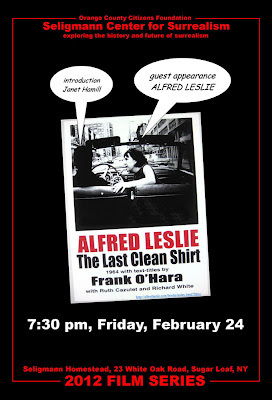
The center is named after Kurt Seligmann, who in his time was an important Surrealist artist who maintained a home and studio in Sugar Loaf. His country place was visited by many other major artists of the European avant-garde like Duchamp, Man Ray, Tanguy, Ernst, Calder, Charles Henri Ford and Meyer Shapiro. Some of these artists also made prints at the Seligmann studio. When Seligmann’s widow Arlette died, she left the building and grounds to be used for the good of the county. In addition to the Surrealism Committee, the estate currently hosts the Orange County Citizen’s Foundation and the Orange County Arts Council.
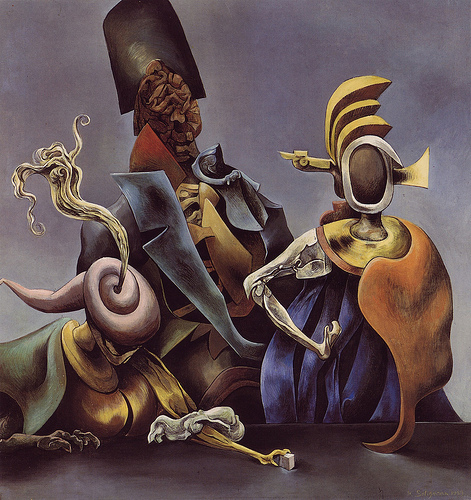 So what exactly is Surrealism? By textbook definition, it is a style of art and literature developed principally in the 20th century, stressing the subconscious or non-rational significance of imagery arrived at by automatism or the exploitation of chance effects, unexpected juxtapositions, and dreams. Poet, writer and teacher William Seaton, who presented a program of his translations from German Dada poets as well as a general account of the Dada movement (which preceded Surrealism in the European avant-garde) explained: “Surrealism relates to something deeper and more real than everyday reality. Dreams, automatic writing – all art seeking some source of information beyond the rational." Hamill added, "the Surrealists felt that the unconscious, or the sur-real (that which was above the real) revealed the truest picture of human nature. Mack offered another perspective, stating, "Surrealism is just a name given to a literary, then visual response to the shocking poverty of a military or capitalist approach to strife. The Surrealists were passionate about urging some encounter with the unconscious as a component in a balanced life.”
So what exactly is Surrealism? By textbook definition, it is a style of art and literature developed principally in the 20th century, stressing the subconscious or non-rational significance of imagery arrived at by automatism or the exploitation of chance effects, unexpected juxtapositions, and dreams. Poet, writer and teacher William Seaton, who presented a program of his translations from German Dada poets as well as a general account of the Dada movement (which preceded Surrealism in the European avant-garde) explained: “Surrealism relates to something deeper and more real than everyday reality. Dreams, automatic writing – all art seeking some source of information beyond the rational." Hamill added, "the Surrealists felt that the unconscious, or the sur-real (that which was above the real) revealed the truest picture of human nature. Mack offered another perspective, stating, "Surrealism is just a name given to a literary, then visual response to the shocking poverty of a military or capitalist approach to strife. The Surrealists were passionate about urging some encounter with the unconscious as a component in a balanced life.”
These art concepts evolved out of the Modernistic movement, starting with the art of Cezanne and his rejection of realism in favor of expressionism and the imagination. This led directly to the development of the avant-garde in Europe in the inter-war years, characterized by the advent of the Dada movement which started in Zurich Switzerland in 1916 at the Cabaret Voltaire under the direction of Hugo Ball and artists like Tristan Tzara. Surrealism took root in the 20’s with Breton and Cubism with Picasso and Braque, and its development in America occurred when European artists immigrated to the U.S. during WW 2. Seligmann was one of those artists.
Interest in Surrealism has extended beyond the Seligmann Estate. In Warwick, at the College of Poetry, Seaton organized numerous literary events, bringing in poets like Bob Holman, Janine Pommy Vega, Ed Harris, Harris Schiff, Joel Lewis and Janet Hamill. Hamill taught a course in Surrealism poetry and offered a poem of her own to illustrate Surrealism at work in writing.
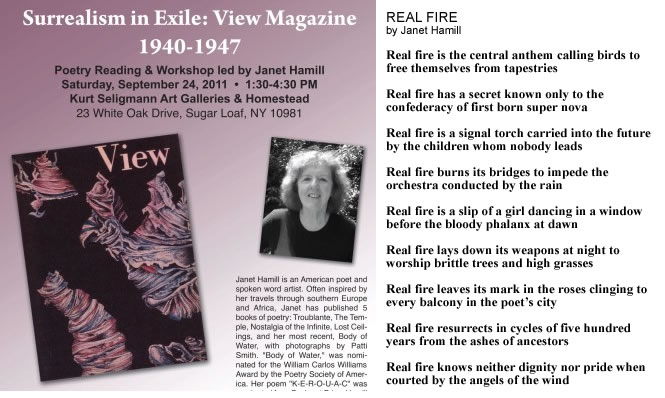 "My poem," she states, "like the films, tries to break the rules of logic, abandoning logic and exposing the subconscious through strong juxtaposition of imagery, which is the primary goal of surrealism."
"My poem," she states, "like the films, tries to break the rules of logic, abandoning logic and exposing the subconscious through strong juxtaposition of imagery, which is the primary goal of surrealism."
At the former Bookstore/Art Gallery Utopian Direction at 7 West St. in Warwick, proprietor and accomplished multi-media artist James Antonie, with his installations and Micro Gallery displays, continued to inform the public of the value of surrealism. Antonie states about his own work: "It's about the juxtaposition between the imagination and the consensus reality of what's real. Art has a way of showing another vision of reality thus changing the way people look at the world."
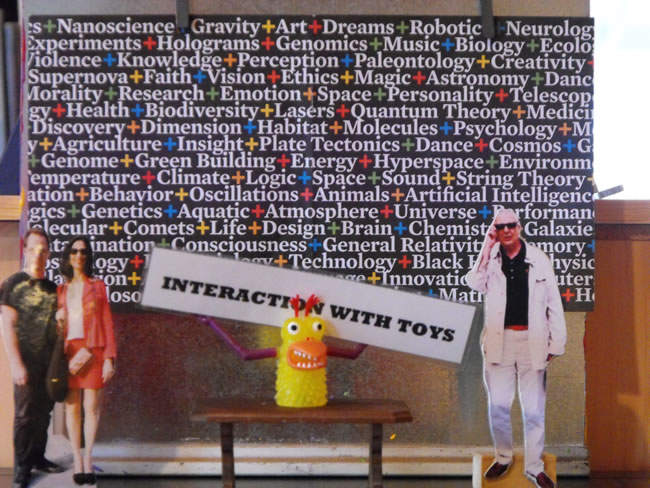 Antonie continues, "My work focuses on the relationship between the microcosm and the macrocosm - the individuation process of becoming a whole person and the integration of specialized knowledge. The individuation process according to Karl Jung is the process of becoming a whole person and discovering the interrelationships of all knowledge." In essence it's the discovery of your true self.
Antonie continues, "My work focuses on the relationship between the microcosm and the macrocosm - the individuation process of becoming a whole person and the integration of specialized knowledge. The individuation process according to Karl Jung is the process of becoming a whole person and discovering the interrelationships of all knowledge." In essence it's the discovery of your true self.
At Utopian Direction, Antonie also featured the work of Jan Sawka, international painter, printmaker and stage designer for the Grateful Dead, Beat Keerl, painter and photographer who was also the manager of the Andre Emmerich Gallery on 57th St. NYC, and Michael Fabian, innovative contemporary painter and musician. The photography of Beat poets by Monica Antonie and the One More Beat event with 100,000 Poets for Change featuring the readings of Harris Schiff were just a handful of activities at Utopian Direction where one sees the influence of Surrealism on individual artists.
Perhaps one important result of the interest in Surrealism is that it has promoted interactions and connections with the creative community, which has developed into Artist Salons going on in individual homes, studios in Orange County, and the Seligmann itself, when on the last Thursday of each month, one can take part in The Artist Salon. The participants in these Salons, like they did in the past, all have their circles of friendships and influences that they bring to the table for an interesting and inspiring discourse. The intermingling of these circles of information and interconnections become an inspiration for all those involved.
Today, fine art has mixed references to popular culture with the incessant cross fertilization between 20th century art and less exalted forms of visual and audio culture which has long been known, like Picasso and Braque’s introduction of the newsprint of Parisian popular press into synthetic cubist collages; Roy Lightenstein’s careful clippings and adjusting of ordinary comic books to form his pop art paintings; Andy Warhol’s soup cans and appropriated images of the popular culture in which advertising borrows from fine art and fine art borrows from advertising; the influence of Marcel Duchamp and the readymades which brought about conceptual art; the works of Rauschenberg and Jasper Johns, in the assemblage processes of found materials.
Performance art, video art installation, earth art outside the art establishment spaces of galleries, and computer art are all evolving with a vast array of local and international artists experimenting and synthesizing all styles and genres. And for all of this, we can acknowledge the importance of the Surrealist contribution to modern and post modern art and culture.
An Artist's Inspiration: Landscapes of Warwick's Village
- Details
- Published: 11 November 2011 11 November 2011
In May, 2011 Janet Howard-Fatta begins her plein air painting series in the village of Warwick...
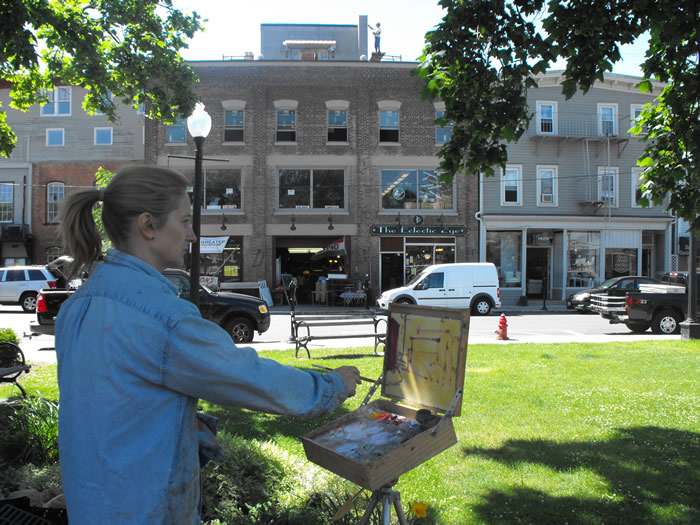
Janet painted in all kinds of weather conditions. She writes:
I have found out that my umbrella is only water resistant, not waterproof.
Today I painted in the car, (inspired by a fellow AIP member that I met at our event in Nyack, Crista Piscano). I sat in my car on Main Street, luckily my husbands car has a sunroof, and allowed me to sit in the light and paint. The car has some serious tinted windows, so that cut down on some of the light. It was so misty out today, I awoke feeling damp and figured I try something new to avoid getting saturated.
The light kept changing with the density of the clouds and so I got a little indecisive with the color of the shadows, I could have worked on it 3 more hours.
My friend Matthew came by and took a shot of me, I wasn’t quite finished with the painting at this point. I really want to paint Akins in the evening when those aluminum letters pick up all the colors reflected from the setting sun. Another day…
Janet kept a journal recording her thoughts...
10 reasons why I love painting outside in the Village of Warwick.
10. My palette staying wet and not wasting any paint.
9. The feeling that I am capturing a moment in history, it seems important.
8. The aroma of delicious food wafting through the air.
7. The unexpected gift of getting a jump start of my summer highlights in my hair.
6. Watching the light shift and change at different times of day and how that affects color.
5. Seeing all my different artist friends around town, there are so many of you.
4. Meeting new friendly people on the street.
3. This goal has caused me to have a huge excuse of why there are dirty dishes in the sink and the laundry not done.
2. The feeling that I can’t stop painting, That it is something that I have to do everyday.
It is so hard to choose the #1 reason, there is part of me that wants to say it is Cappucino Crunch ice cream cones at Cafe A la Mode, but the truth is I did not buy one of those cones, because I love it too much that I have to stay away.
1. The real # one reason is painting plein-air keeps me in the moment, in that power of now and makes me feel so alive and in tune to the world around me. It satisfies my intellectual connection to the history of art, the sound of the birds, fills my spirit and physically sets me up to be present. And those two hours that I spent outside recharges me in other areas of my life.
Here we discover her unique connection to the Village of Warwick as a special place and experience her process of making art...
I love antiques, I love architecture, and The Eclectic Eye is one of my favorite Warwick shops. I wanted to paint a store front, and I chose the eclectic eye because the store front is kind of like a visual musical grid to me. After I did a sketch, it was decided that this was the location for the day.
I stood on Railroad Green under the shade of a a huge Maple. I met the man who welded Fredrick Franck’s sculptures for 22 years, he enchanted me with his stories while I painted.
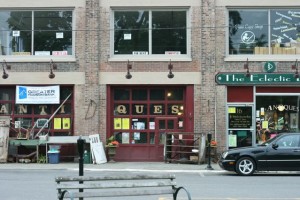
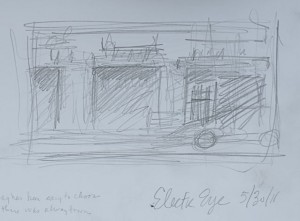
At first, I look and keep looking, mixing up colors before I paint. I find my lights in warm and cold tones, and my darks in warm and cool tones, and local colors – on the dark side. Then I begin to apply paint, usually in blocks of color. Sometimes I start with pure color, and sometimes I start with dark shadows. Here the dark shadows helped define the space. I took photos along the way, and made a progression semi-slide show of the development of this piece.
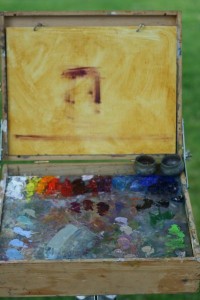
When I was done, I realized it was Sunday Morning, and I recalled Edward Hopper’s Sunday morning. How very Ironic. And I laughed and said it was a Janet Hoppard, how cliche and ridiculous, but it made me laugh!
From Sept 1 -30, 2011, Janet featured those plein air paintings and presented them as part of an exhibition at the Albert Wisner Library entitled An Artist's Inspiration: Landscapes of Warwick's Village and Town.
Janet writes: "For me as an artist, this is about looking deeper at a place, past the pretty scenery, experiencing it and capturing a fleeting moment. It is also the art of finding beauty everywhere and about possibility. I was very inspired by the Edward Hopper Exhibit this winter at the Whitney. Warwick has that quaint, wholesome character that is typical in Hopper's work. Through the use of color temperature, light and atmosphere, I'm hoping the unique sense of Warwick can be experienced through my paintings. In spring a whole new breath gets cast into the air in the Hudson Valley with blossoms and farmers markets and I was delighted to be outside painting in it with people on the streets of Warwick. It is a fantastic place to live.
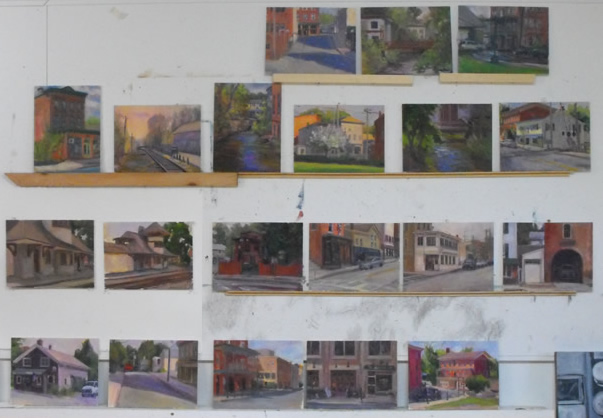
 Hudson Valley artist Janet Howard-Fatta creates a variety of works from landscapes in oil depicting place and time, to figurative works in wet and dry media. Light, color and a love of nature are the driving forces behind her work. Janet's work reflects a relationship between the world around her and the painted image. She strives to create a visual representation of what she experiences through her senses. Janet is a Pratt Graduate, currently a board member of Artists in the Parks, and facilitates the Warwick Life Drawing Group. She lives in Warwick, NY with her husband and two children.
Hudson Valley artist Janet Howard-Fatta creates a variety of works from landscapes in oil depicting place and time, to figurative works in wet and dry media. Light, color and a love of nature are the driving forces behind her work. Janet's work reflects a relationship between the world around her and the painted image. She strives to create a visual representation of what she experiences through her senses. Janet is a Pratt Graduate, currently a board member of Artists in the Parks, and facilitates the Warwick Life Drawing Group. She lives in Warwick, NY with her husband and two children.
To read a previous story about Janet Howard-Fatta, we recommend our feature story Fine Arts, Finding Balance and Family Life with Artists Janet and Louis Fatta. Includes video coverage of Louis Fatta's artmaking process.
To purchase Janet's book of paintings about the village, click here.
To purchase Janet's notecards, visit her website and Postal Plus in New Milford.
For more info about her Upcoming Exhibit: Trailworks Holiday Exhibit "Good Things, Small Packages"- November 12th-January 8th, 2012 click here
Janet will be offering a spring Plein Air Painting Workshop - Saturday, April 21-22nd, 2012 - 9AM-2PM. For more information, click here.
Susan Hope Fogel: Featured Artist
- Details
- Published: 03 December 2010 03 December 2010
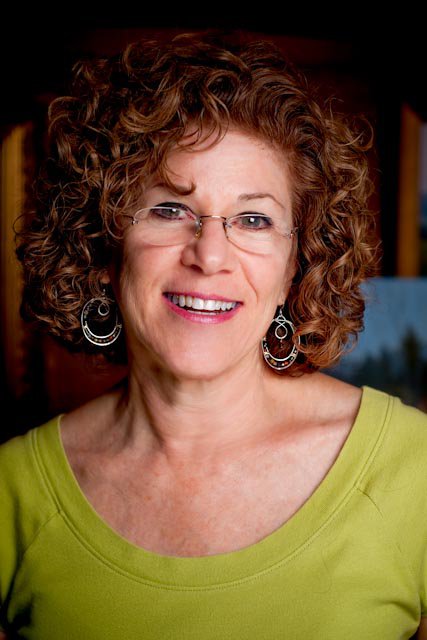
Artist Biography:
After teaching painting and drawing on the high school level, for ten years, Susan went back to school to continue her art studies at The New York Academy of Art in New York City. The Academy was one of the first schools in the U.S. to base its curriculum on the classical European tradition of drawing from plaster casts. Intensive drawing from the casts was her focus for 18 months before moving on to the Art Students League and The National Academy of Design, both in NYC. With advanced skills in drawing developed at the Academy Susan went on to life studies from the model at these schools to work with painters Harvey Dinnerstein and Ron Sher.
With her family’s move out of New York City, to Warwick, NY, Susan developed an interest in painting the inspiring landscape of New York’s Hudson Valley. The landscape that had once inspired the Hudson River School painter, Jasper Cropsey, when he lived in Warwick, now was her source of inspiration.
At this time Susan attended the Ridgewood Art Institute, in New Jersey, to work with master landscape painter, John Philip Osborne. She credits Mr. Osborne for developing her painter’s eyes.
The Institute maintains a tradition of teaching that was passed down from generation to generation of painters. Mr. Osborne had studied with Arthur Maynard who had studied with Frank Vincent Dumond at the Art Students League in New York. When Dumond studied in Europe he was influenced by the Barbizon and Impressionist styles of painting. “In his frequent trips to the French countryside, Dumond was disciplined in painting the naturalistic landscape. Many Barbizon School landscape precepts-such as a sublime vision of the natural world, and an interest in the transient effects of light and shade to depict and dramatize it- have been handed down through generations of painters and continue to pervade art theory today.”*
“Dumond students were taught to see the progression of prismatic light flowing from yellow to red to violet on the warm side; and from yellow to green to blue-green to violet on the cool side.” A variation of Dumond’s palette is still used by many students of this tradition. Susan works with this palette and continues this tradition that started in Europe and continues to thrive today.*
Susan is the director of The Warwick Atelier, a studio school, that is dedicated to teaching the drawing and painting principles of representational art. Among many other awards, Susan has won Best in Show in The Ridgewood Art Institute’s annual exhibit for her landscape painting,”Westtown Morning”.
Her work has been reviewed by Raymond Steiner in Art Times and American Artist Magazine, discussed her work in an article entitled ”Painting in North Light.” She exhibits her work in galleries in Santa Fe, Boston and Cape Cod.
She is member of The Copley Society of Art, The Pastel Society of America, the Hudson Valley Art Association, The Ridgewood Art Institute and The Warwick Art League.
*Ridgewood Art Institute Catalogue 2004

